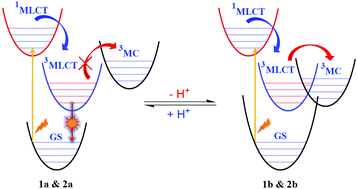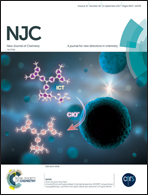The effect of an ancillary ligand proton on the photophysical properties of some RuIIN6 cores: a proton valve†
Abstract
Reaction of benzil mono-(2-pyridyl)hydrazone (LH; H is the dissociable proton) with cis-[Ru(N–N)2Cl2]·2H2O (N–N ≡ 2,2′-bipyridine and 1,10-phenanthroline) in methanol yields complexes of the type [Ru(N–N)2(LH)](ClO4)2 (1a and 2a). Their pKa values in CH3CN are determined from solution conductivity as 4.35 and 3.83. Deprotonation of the two complexes by the addition of triethylamine in methanol gives complexes of the type [Ru(N–N)2L]ClO4 (1b and 2b). The X-ray crystal structures of 1a and 2b have been determined to confirm the presence/absence of the LH proton. In the electronic spectra of the deprotonated complexes 1b and 2b in CH3CN, a prominent metal centered transition is observed at 340 nm, which is generally not seen clearly in complexes containing the RuIIN6 core. A fast electron transfer process Ru(III) + e− = Ru(II) is observed in cyclic voltammetry with an E1/2 of 0.8 V vs. NHE in 1b and 2b with a heterogeneous rate constant (ks,h) of 1.39 × 10−2 and 1.29 × 10−2 cm s−1, respectively. Weak emissions at 615 nm with a quantum yield of 7 × 10−4–1 × 10−4 are observed in the fluorescence spectra of 1a and 2a when excited at 430 nm in deaerated CH3CN. But 1b and 2b do not fluoresce. Such different photophysical behaviour is explained in terms of the fact that, while a 3MLCT is the lowest excited state in 1a and 2a (where the LH proton is present), the reactive 3MC is the lowest excited state in 1b and 2b (where the LH loses the proton). It is pointed out that the proton acts as a valve in the conduit for the radiative pathways. Various experimental results obtained here are supported by detailed density functional theory (DFT) calculations at the BP86/LanL2DZ level.



 Please wait while we load your content...
Please wait while we load your content...